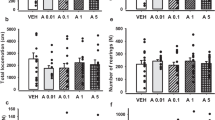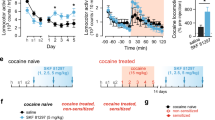Abstract.
Rationale: The role played by D1-like receptors in amphetamine-induced behavioral sensitization has been examined using both the D1-like receptor antagonist, SCH 23390, and the D1A receptor knockout mouse (i.e. D1A-deficient mice). Studies using these two approaches have provided conflicting evidence about the importance of D1-like receptors for amphetamine-induced behavioral sensitization. Objective: The purpose of the present study was to determine: (a) whether D1A-deficient mice exhibit amphetamine-induced locomotor sensitization after 3 and 17 drug abstinence days, and (b) whether SCH 23390, which binds to both D1A and D1B receptor subtypes, blocks development of amphetamine sensitization in wild-type and D1A-deficient mice. Methods: In the first experiment, adult wild-type and D1A-deficient mice were injected with amphetamine (0, 1, 2, 4, or 8 mg/kg, IP) for 7 consecutive days. In the second experiment, wild-type and D1A-deficient mice were pretreated with SCH 23390 (0, 0.15, or 0.5 mg/kg, IP) 30 min prior to being injected with amphetamine (0 or 8 mg/kg, IP). After each daily amphetamine injection, mice were placed in activity chambers where distance traveled (i.e. horizontal locomotor activity) was measured for 60 min. On the test days, which occurred after 3 or 17 drug abstinence days, mice were injected with 1 mg/kg amphetamine and locomotion was measured for 120 min. Results: Both wild-type and D1A-deficient mice exhibited amphetamine-induced locomotor sensitization. Pretreatment with 0.5 mg/kg SCH 23390 blocked the development of locomotor sensitization in wild-type mice, but did not alter the sensitized responding of D1A-deficient mice. Conclusions: It appears that D1-like receptors are necessary for the development of amphetamine sensitization in wild-type mice, while neither the D1A nor D1B receptor subtypes are necessary for the amphetamine-induced locomotor sensitization of D1A-deficient mice. A possible explanation for these conflicting results is that D1A-deficient mice may have a compensatory mechanism (not involving D1B receptors) that allows them to exhibit amphetamine-induced behavioral sensitization in the absence of the D1A receptor.
Similar content being viewed by others
Author information
Authors and Affiliations
Additional information
Electronic Publication
Rights and permissions
About this article
Cite this article
Karper, P.E., De La Rosa, H., Newman, E.R. et al. Role of D1-like receptors in amphetamine-induced behavioral sensitization: a study using D1A receptor knockout mice. Psychopharmacology 159, 407–414 (2002). https://doi.org/10.1007/s00213-001-0936-7
Received:
Accepted:
Issue Date:
DOI: https://doi.org/10.1007/s00213-001-0936-7




